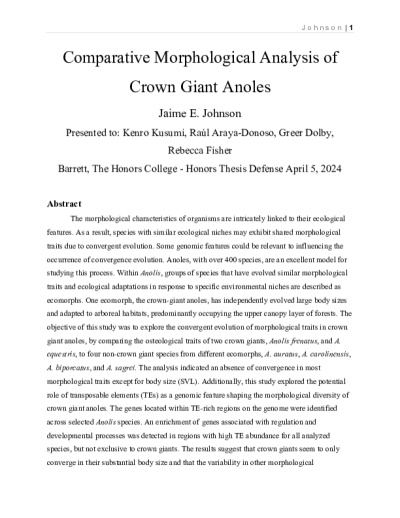Filtering by
- All Subjects: Evolution
- Creators: Kusumi, Kenro
- Creators: Lynch, Michael

To determine if the disruption of the MMR pathway results in the reduced conservation of methylated adenines as well as an increased tolerance for mutations that result in the loss or gain of new GATC sites, we surveyed individual clones isolated from experimentally evolving wild-type and MMR-deficient (mutL- ;conferring an 150x increase in mutation rate) populations of E. coli with whole-genome sequencing. Initial analysis revealed a lack of mutations affecting methylation sites (GATC tetranucleotides) in wild-type clones. However, the inherent low mutation rates conferred by the wild-type background render this result inconclusive, due to a lack of statistical power, and reveal a need for a more direct measure of changes in methylation status. Thus as a first step to comparative methylomics, we benchmarked four different methylation-calling pipelines on three biological replicates of the wildtype progenitor strain for our evolved populations.
While it is understood that these methylated sites play a role in the MMR pathway, it is not fully understood the full extent of their effect on the genome. Thus the goal of this thesis was to better understand the forces which maintain the genome, specifically concerning m6A within the GATC motif.

Agassiz’s desert tortoise (Gopherus agassizii) is a long-lived species native to the Mojave Desert and is listed as threatened under the US Endangered Species Act. To aid conservation efforts for preserving the genetic diversity of this species, we generated a whole genome reference sequence with an annotation based on deep transcriptome sequences of adult skeletal muscle, lung, brain, and blood. The draft genome assembly for G. agassizii has a scaffold N50 length of 252 kbp and a total length of 2.4 Gbp. Genome annotation reveals 20,172 protein-coding genes in the G. agassizii assembly, and that gene structure is more similar to chicken than other turtles. We provide a series of comparative analyses demonstrating (1) that turtles are among the slowest-evolving genome-enabled reptiles, (2) amino acid changes in genes controlling desert tortoise traits such as shell development, longevity and osmoregulation, and (3) fixed variants across the Gopherus species complex in genes related to desert adaptations, including circadian rhythm and innate immune response. This G. agassizii genome reference and annotation is the first such resource for any tortoise, and will serve as a foundation for future analysis of the genetic basis of adaptations to the desert environment, allow for investigation into genomic factors affecting tortoise health, disease and longevity, and serve as a valuable resource for additional studies in this species complex.
Data Availability: All genomic and transcriptomic sequence files are available from the NIH-NCBI BioProject database (accession numbers PRJNA352725, PRJNA352726, and PRJNA281763). All genome assembly, transcriptome assembly, predicted protein, transcript, genome annotation, repeatmasker, phylogenetic trees, .vcf and GO enrichment files are available on Harvard Dataverse (doi:10.7910/DVN/EH2S9K).




